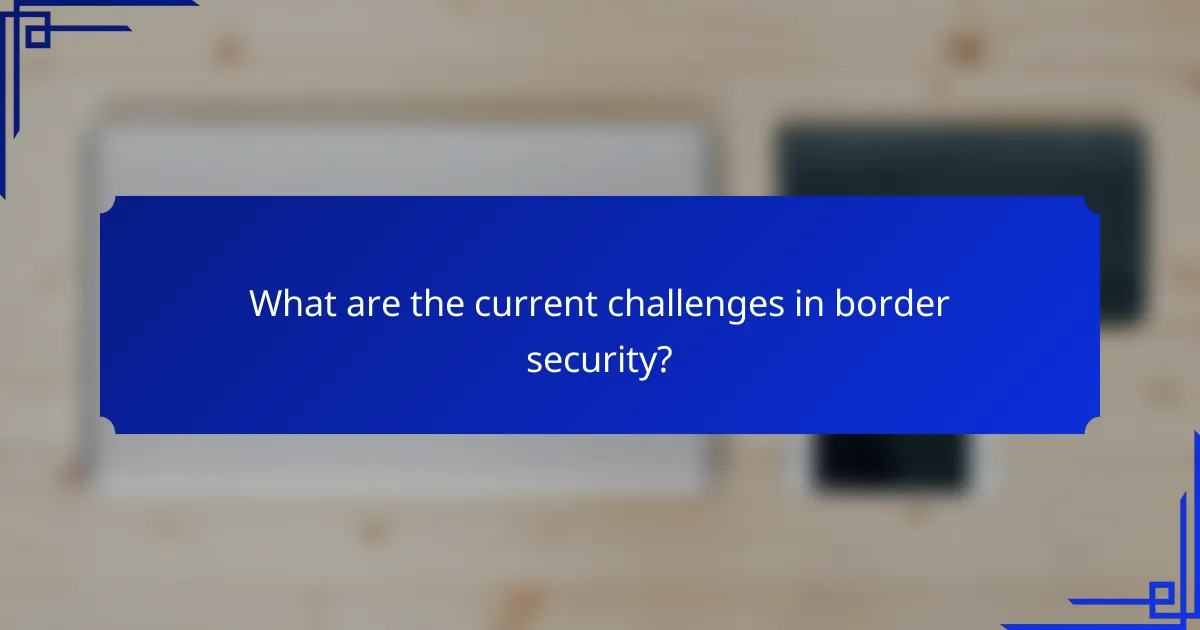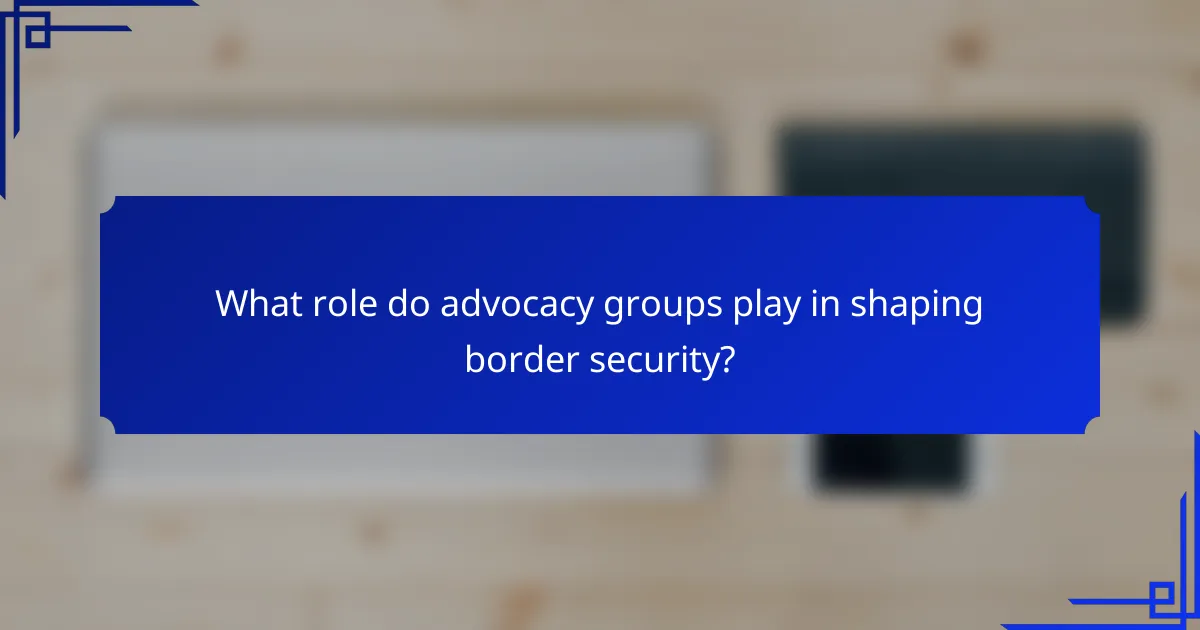Brian Terry’s tragic death in 2010 has had a profound impact on border security policies, drawing attention to the dangers of illegal crossings and the complexities of drug trafficking. His story, intertwined with the controversies of Operation Fast and Furious, has prompted lawmakers to reevaluate enforcement strategies and emphasize the need for accountability in law enforcement. As discussions around immigration reform continue, Terry’s legacy serves as a stark reminder of the consequences of policy failures and the urgent need for effective security measures.

How does Brian Terry’s story impact border security policies?
Brian Terry’s story has significantly influenced border security policies by highlighting the dangers associated with illegal border crossings and the need for enhanced enforcement measures. His tragic death brought national attention to the issues of drug trafficking and illegal immigration, prompting lawmakers to reconsider existing security strategies.
Increased funding for border enforcement
In response to the heightened awareness surrounding border security, funding for border enforcement has seen substantial increases. This financial boost is often allocated to various initiatives, including the deployment of additional Border Patrol agents, advanced surveillance technology, and improved infrastructure along the U.S.-Mexico border.
For example, recent budgets have proposed billions of dollars specifically aimed at enhancing border security, reflecting a commitment to preventing similar tragedies in the future. This funding is crucial for maintaining a robust security presence and addressing the complexities of border management.
Changes in legislation for border security
Brian Terry’s story has catalyzed changes in legislation aimed at strengthening border security measures. Lawmakers have introduced new bills that focus on increasing penalties for human trafficking and drug smuggling, as well as enhancing cooperation between federal and local law enforcement agencies.
Moreover, legislative efforts have included provisions for better training and resources for border security personnel. These changes are designed to create a more effective response to the challenges posed by illegal crossings and to ensure that law enforcement has the necessary tools to protect both citizens and border agents alike.

What are the key events in Brian Terry’s story?
Brian Terry’s story is marked by significant events that highlight issues in border security and law enforcement. His tragic death in 2010 and the subsequent revelations about Operation Fast and Furious have profoundly influenced current border security policies and discussions around gun control.
Brian Terry’s murder in 2010
Brian Terry, a U.S. Border Patrol agent, was killed in December 2010 while on patrol near the U.S.-Mexico border. His murder underscored the dangers faced by law enforcement in border regions and raised questions about the effectiveness of existing security measures.
The circumstances surrounding his death prompted widespread media attention and public outcry, leading to increased scrutiny of border security practices and the need for improved safety protocols for agents working in high-risk areas.
Operation Fast and Furious involvement
Operation Fast and Furious was a controversial Bureau of Alcohol, Tobacco, Firearms and Explosives (ATF) initiative aimed at tracking illegal gun sales to Mexican drug cartels. The operation inadvertently allowed firearms to fall into the hands of criminals, including those involved in Brian Terry’s murder.
The fallout from this operation has led to significant policy changes and calls for greater accountability in federal law enforcement operations. It has also fueled debates over gun control and the need for stricter regulations on firearm sales, particularly in border states.

What lessons can be learned from Brian Terry’s story?
Brian Terry’s story highlights the critical need for accountability in law enforcement and the urgency for comprehensive immigration reform. His tragic death underscores the consequences of policy failures and the importance of effective border security measures.
Importance of accountability in law enforcement
Accountability in law enforcement ensures that agencies operate transparently and uphold the law without bias. The lack of accountability can lead to misuse of power and ineffective responses to crime, as seen in the circumstances surrounding Terry’s death.
To foster accountability, law enforcement agencies should implement regular audits, establish clear protocols for operations, and encourage community oversight. This can help build trust between law enforcement and the communities they serve, ultimately leading to more effective policing.
Need for comprehensive immigration reform
Comprehensive immigration reform is essential to address the complexities of border security and immigration policies. Current systems often leave gaps that can be exploited, contributing to dangerous situations like those faced by Brian Terry.
Effective reform should include pathways for legal immigration, better tracking of individuals crossing the border, and enhanced cooperation between agencies. By creating a more structured immigration system, the risks associated with illegal crossings can be significantly reduced, benefiting both national security and community safety.

How have policies evolved since Brian Terry’s death?
Since Brian Terry’s tragic death in 2010, border security policies have undergone significant changes aimed at enhancing safety and preventing similar incidents. These changes focus on stricter enforcement measures and improved inter-agency cooperation to address the complexities of border security.
Implementation of stricter border patrol measures
Stricter border patrol measures have been introduced to reduce illegal crossings and enhance the safety of border agents. This includes increased personnel deployment, advanced surveillance technologies, and the use of drones for real-time monitoring of border areas.
Additionally, policies now emphasize the use of barriers and fencing in high-traffic areas, which has led to a more fortified border. While these measures aim to deter illegal immigration, they also raise discussions about the humanitarian impacts on migrants.
Enhanced collaboration between agencies
Enhanced collaboration between various federal, state, and local agencies has become a cornerstone of modern border security policy. Agencies like the Department of Homeland Security (DHS) and Customs and Border Protection (CBP) now work closely with local law enforcement to share intelligence and resources.
This collaboration includes joint task forces and information-sharing platforms that facilitate quicker responses to border incidents. By pooling resources and expertise, agencies can better address the multifaceted challenges of border security, leading to more effective enforcement and safety measures.

What are the current challenges in border security?
Current challenges in border security include resource allocation, funding shortages, and the need to balance security measures with humanitarian concerns. These issues complicate the enforcement of policies aimed at protecting national borders while addressing the needs of migrants and asylum seekers.
Resource allocation and funding issues
Resource allocation and funding are critical challenges affecting border security. Many agencies struggle with limited budgets, which can lead to inadequate staffing, outdated technology, and insufficient training for personnel. For instance, border patrol units may lack the necessary equipment to effectively monitor vast stretches of land.
To address these issues, governments should prioritize investments in technology and personnel. This could involve reallocating funds from less critical areas or seeking additional funding through grants or partnerships with private organizations. Effective resource management can enhance operational efficiency and improve overall security outcomes.
Balancing security with humanitarian concerns
Balancing security with humanitarian concerns is a pressing challenge in border security policies. While it is essential to maintain national security, it is equally important to ensure that the rights and needs of migrants are respected. This often requires a nuanced approach that considers both safety and compassion.
For example, policies that prioritize humane treatment of asylum seekers can help build trust between border enforcement agencies and communities. Implementing training programs for border agents on handling sensitive situations can foster a more empathetic approach. Striking this balance is crucial for creating effective and just border security measures.

How do public perceptions of border security influence policies?
Public perceptions of border security significantly shape policies by influencing political agendas and legislative actions. When citizens express heightened concern over border safety, policymakers often respond with stricter regulations and increased funding for security measures.
Media coverage shaping public opinion
Media coverage plays a crucial role in shaping public opinion on border security. Sensationalized reporting on border incidents can lead to increased fear and urgency among the public, prompting calls for more stringent policies. For instance, high-profile cases involving illegal crossings or drug trafficking often dominate headlines, skewing perceptions toward viewing the border as a crisis point.
Moreover, the framing of border security in the media can influence how people perceive the effectiveness of existing policies. Positive coverage of successful operations may bolster support for current measures, while negative stories about failures can lead to demands for reform.
Political rhetoric and its impact on legislation
Political rhetoric surrounding border security can significantly impact legislation. Politicians often use strong language to resonate with constituents, emphasizing threats and the need for immediate action. This rhetoric can lead to the introduction of bills aimed at enhancing border security, even in the absence of comprehensive studies supporting such measures.
Additionally, the alignment of political parties with specific narratives about border security can create polarized views among the electorate. For example, a party advocating for stricter immigration controls may gain support from voters who feel insecure, while another party promoting more lenient policies may appeal to those prioritizing humanitarian concerns. This dynamic can result in fluctuating legislative priorities based on prevailing public sentiments.

What role do advocacy groups play in shaping border security?
Advocacy groups significantly influence border security policies by raising awareness, lobbying for reforms, and holding authorities accountable. They often represent the interests of marginalized communities and push for humane treatment and legal protections at the borders.
Influence of organizations like the ACLU
The American Civil Liberties Union (ACLU) plays a crucial role in shaping border security by challenging unconstitutional practices and advocating for civil rights. Through litigation, public campaigns, and policy advocacy, the ACLU highlights issues such as unlawful detentions and surveillance practices at the border.
By filing lawsuits and providing legal assistance, the ACLU not only defends individual rights but also influences public opinion and legislative changes. Their efforts often lead to increased scrutiny of government actions and promote transparency in border security operations.
Grassroots movements advocating for reform
Grassroots movements are essential in advocating for comprehensive border security reform by mobilizing communities and raising awareness about the impacts of current policies. These movements often focus on human rights, emphasizing the need for policies that prioritize safety without compromising dignity.
Local organizations frequently organize protests, educational events, and campaigns to engage the public and policymakers. By fostering community involvement, they amplify voices that may otherwise be overlooked, pushing for changes that reflect the values of justice and equity in border security practices.
